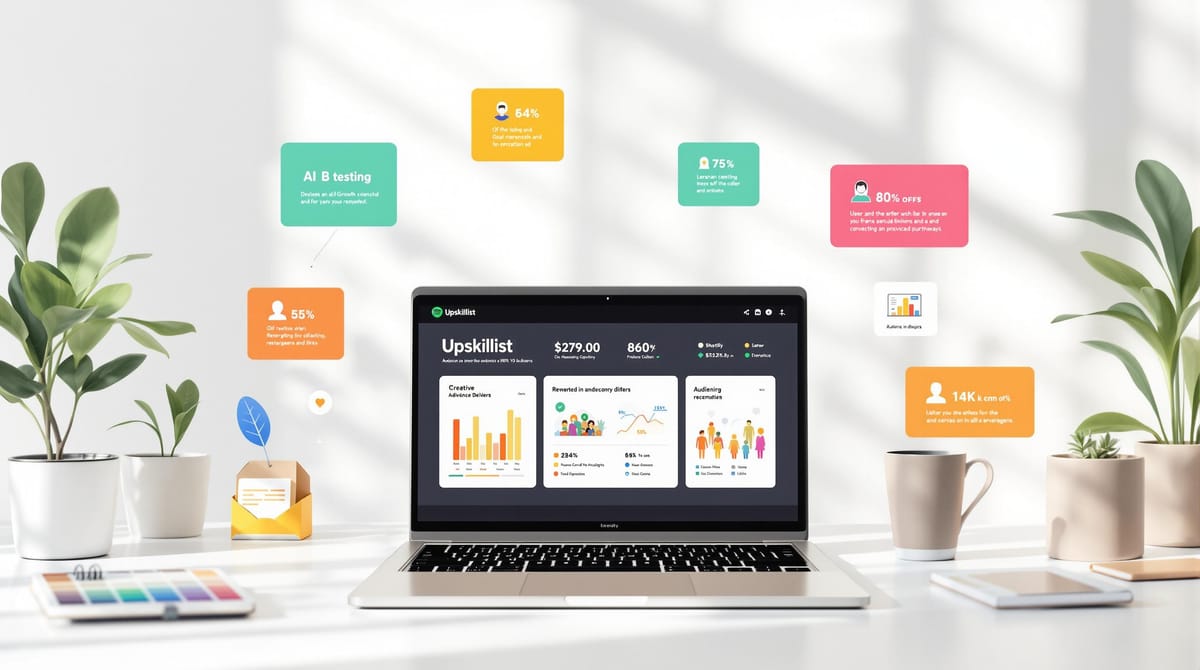A/B Testing Retargeting Ads: Step-by-Step Guide
Learn how to improve your retargeting ads through effective A/B testing, focusing on metrics, audience segmentation, and actionable insights.

A/B testing retargeting ads is about comparing two ad versions by changing one element at a time (like a headline or image) to see which performs better. Why does this matter? It helps improve ad performance, save costs, and boost engagement by relying on real data instead of guesswork.
Key Steps to Get Started:
- Set Clear Goals: Focus on metrics like conversion rate, cost per acquisition (CPA), or return on ad spend (ROAS).
- Test One Element at a Time: Examples include ad creative, copy, offers, landing pages, or audience segments.
- Segment Your Audience: Group users by behavior, cart status, or purchase history for targeted insights.
- Use Testing Tools: Platforms like Facebook Ads Manager or Google Ads simplify setup and tracking.
- Measure Results: Track metrics like click-through rate (CTR), conversions, and cost efficiency. Aim for statistically valid results (e.g., 95% confidence level).
Why It Matters:
- Better Targeting: Find out which messages work for specific audiences.
- Cost Efficiency: Avoid wasting budget on underperforming ads.
- Higher Engagement: Learn what drives clicks and conversions.
Start small, analyze results carefully, and keep refining to improve your campaign's ROI. A/B testing isn't a one-time task - it’s an ongoing process to optimize your retargeting strategy.
Test Remarketing and Prospecting Ad Sets vs. Advantage+ ...
Preparing Your A/B Test
Here’s how to set up your A/B test for actionable insights.
Setting Test Goals
Start by defining clear, measurable objectives tied to your key performance indicators (KPIs). Focus on metrics that directly influence your business outcomes, such as conversion rate, cost per acquisition (CPA), or return on ad spend (ROAS). Secondary metrics like click-through rate (CTR), engagement, or average order value can also provide helpful context.
For example, if you’re aiming to boost conversion rates, set a specific target based on past performance. Make sure your goal aligns with cost efficiency. Once your objective is clear, decide on the element you want to test.
Selecting Test Elements
Test one element at a time to ensure your results are clear and actionable. Here are some common areas to focus on:
| Test Element | What to Test | Impact Potential |
|---|---|---|
| Ad Creative | Images, videos, colors | High |
| Ad Copy | Headlines, body text, CTAs | High |
| Offer | Discounts, promotions, incentives | Medium |
| Landing Page | Layout, messaging, forms | Medium |
| Audience | Segmentation, timing, frequency | High |
Creating Audience Groups
Segmenting your audience can provide more reliable insights. Divide your retargeting audience based on factors like:
- Visit behavior: Compare recent visitors to those from earlier sessions.
- Page depth: Distinguish users who only viewed the homepage from those who explored product pages.
- Cart status: Separate cart abandoners from casual browsers.
- Purchase history: Look at first-time buyers versus returning customers.
Make sure each group is large enough to provide statistically valid results. Split your audience randomly and evenly across variants to maintain test accuracy.
Testing Platform Setup
Use built-in A/B testing tools from platforms like Facebook Ads Manager or Google Ads to streamline the process.
1. Campaign Structure
Set up equal ad sets for each variant while keeping all other variables constant. Distribute your budget evenly, choose a campaign duration that allows for sufficient data collection, and maintain consistent targeting and bidding strategies.
2. Tracking Setup
Install conversion pixels, configure custom events, and enable detailed goal tracking to collect accurate data.
3. Quality Control
Before launching your test, double-check the following:
- Both variants are tagged correctly.
- Tracking systems are working as expected.
- Budgets are distributed equally.
- Audience segments are distinct and non-overlapping.
Platforms like Upskillist offer hands-on training to help you master these tools.
Running Your Test
Starting the Test
Once your tracking systems are ready and your budget is allocated, launch your test during a normal business period to avoid unusual results. Run both variants at the same time to ensure they get equal exposure. In the first 24 hours, double-check these critical elements:
- Traffic distribution: Ensure the audience split is close to 50/50.
- Budget pacing: Confirm spending is evenly distributed between the variants.
- Tracking accuracy: Make sure conversion data is being recorded correctly.
Set up alerts to catch any major performance deviations early. Also, take note of external factors like competitor promotions or market shifts that might influence your test. Then, keep an eye on key performance metrics as your test progresses.
Measuring Results
Track your key performance metrics in real time. Pay attention to these categories:
| Metric Category | Primary Metrics | Secondary Metrics |
|---|---|---|
| Engagement | Click-through rate (CTR) | Time on site |
| Conversion | Conversion rate, CPA | Cart abandonment rate |
| Revenue | ROAS, Average order value | Customer lifetime value |
| Cost | Cost per click (CPC) | Frequency cap impact |
Record trends consistently - daily for short tests and weekly for longer ones. This helps you spot patterns or irregularities that could affect your conclusions.
Reading Test Data
Once the test is complete, use your tracking data and a statistical significance calculator to validate the results. Keep these factors in mind while analyzing:
1. Statistical Confidence
Aim for at least 95% confidence. This usually requires:
- At least 100 conversions per variant
- A minimum of 1,000 impressions per variant
- A testing period of 7–14 days
2. Performance Metrics
Compare the variants across a range of metrics to get a full picture, including:
- Primary conversion goals
- Secondary engagement metrics
- Cost efficiency
- Revenue impact
3. Segment Analysis
Break down the results by audience segments to see where each variant performs best. Consider factors like:
- Device types
- Time of day
- Geographic locations
- Interaction history
Look for consistent trends across multiple data points before making any decisions. Keep in mind that statistical significance doesn’t always mean the results are practical for your business. Always weigh the real-world impact of implementing changes based on your test outcomes.
Improving Campaign Results
Applying Winning Variants
Once a test reveals a top-performing variant, roll it out across your retargeting campaigns. Keep an eye on key metrics like click-through rates, conversion rates, and cost per action to ensure it delivers better results. From there, continue fine-tuning your approach with additional testing.
Strategizing Future Tests
Use your initial findings to plan regular tests that keep your ads performing well. Build a schedule for experimenting with new creative ideas and targeting methods to ensure your campaigns stay sharp and effective.
Testing Guidelines
Single Variable Tests
When conducting A/B tests for retargeting ads, focus on changing only one element at a time. This approach makes it easier to identify which specific change is influencing performance. For instance, if you alter both the ad image and the call-to-action button in a single test, it becomes impossible to determine which adjustment led to the results. Instead, test elements like ad creative (images, videos, headlines), targeting settings (audience segments, placements), ad copy, or bidding strategies separately. Also, make sure your audience size is large enough to produce reliable results.
Test Size Requirements
Once you've narrowed down to a single variable, ensure your test groups are large and evenly split. This reduces the chances of random variations affecting your findings and ensures the data is representative enough to draw accurate conclusions.
Test Frequency Limits
Avoid launching tests back-to-back, as this can lead to audience fatigue and unreliable results. Allow each test to fully conclude before introducing new variants. Use engagement metrics to determine the ideal timing between tests.
Conclusion
Key Takeaways
Running successful A/B tests for retargeting ads requires a clear and focused approach. Test one variable at a time, ensure your sample size is large enough, and time your tests strategically. This way, decisions are based on solid data rather than guesswork, ultimately improving your campaign's ROI.
Remember, A/B testing is a process. Each test offers insights that can refine your targeting and improve your results over time.
Learn More with Upskillist

Want to sharpen your skills in A/B testing for retargeting campaigns? Upskillist offers digital marketing courses designed to give you practical, hands-on experience. These expert-led programs guide you through real testing scenarios, helping you build and optimize effective campaigns.
With these courses, you'll learn how to:
- Set up meaningful tests
- Interpret and act on your results
- Apply winning strategies to your campaigns
- Scale successful campaigns for better outcomes
Start with a 7-day free trial and explore the full range of digital marketing content. Take the first step toward mastering retargeting campaigns today.

